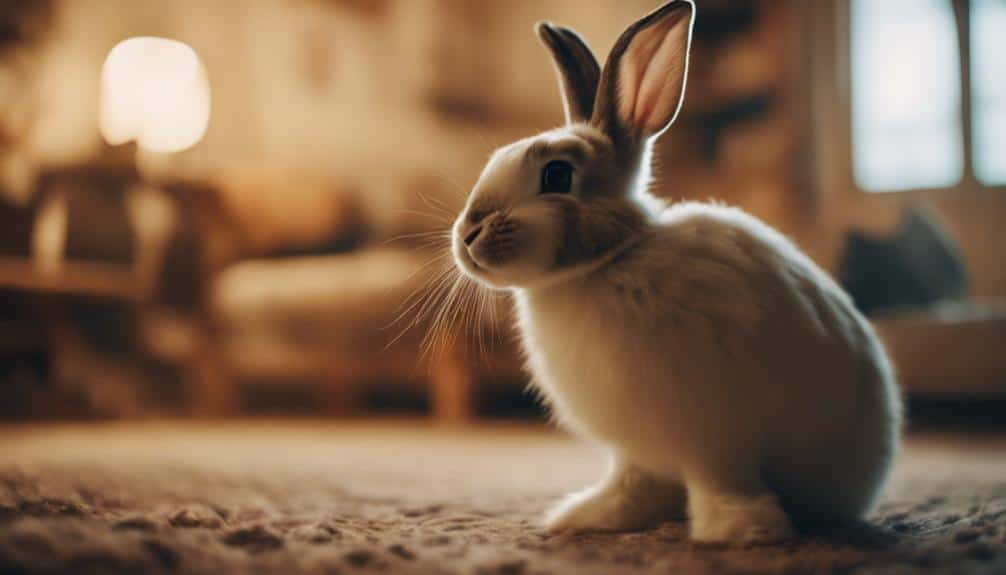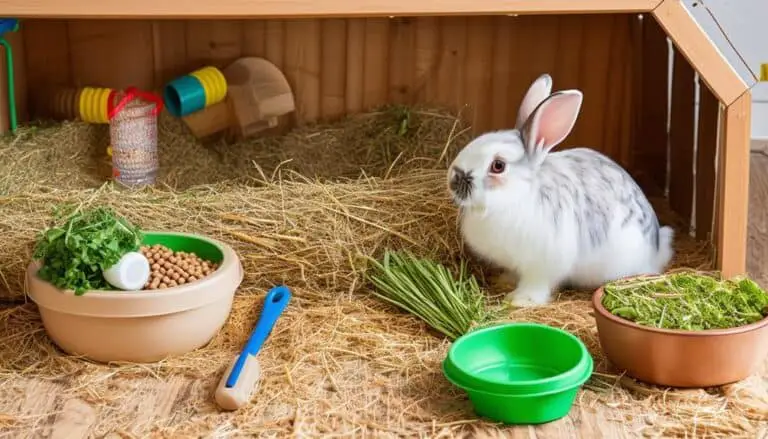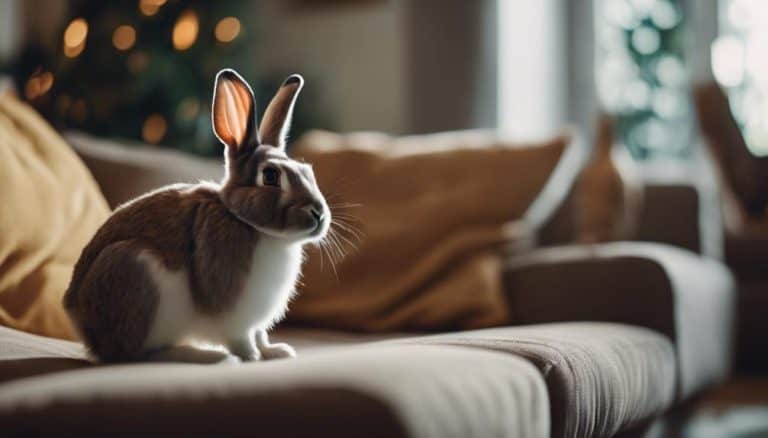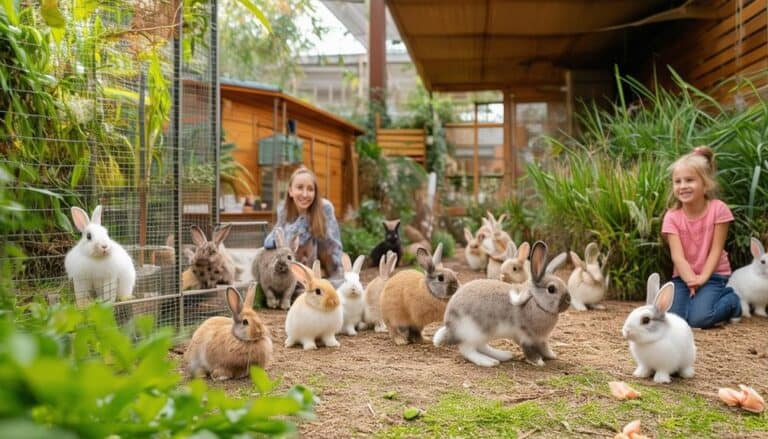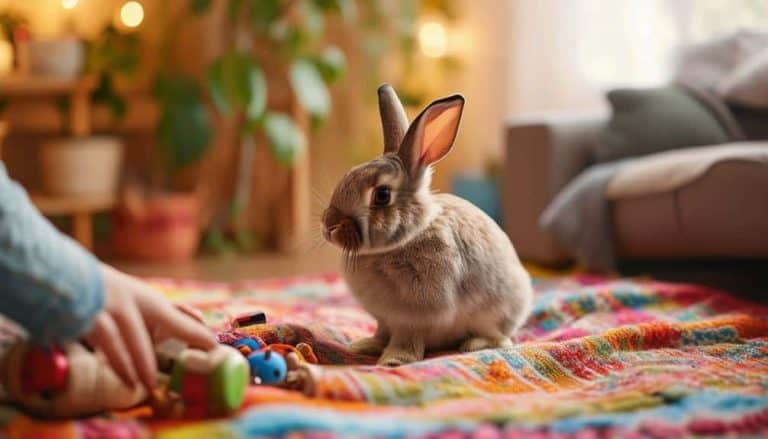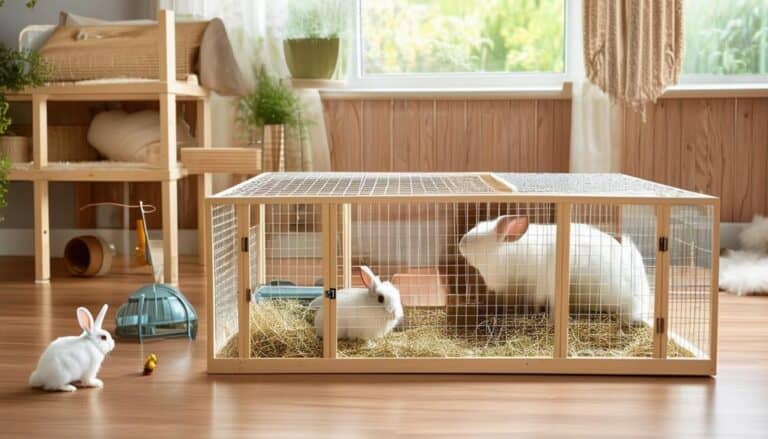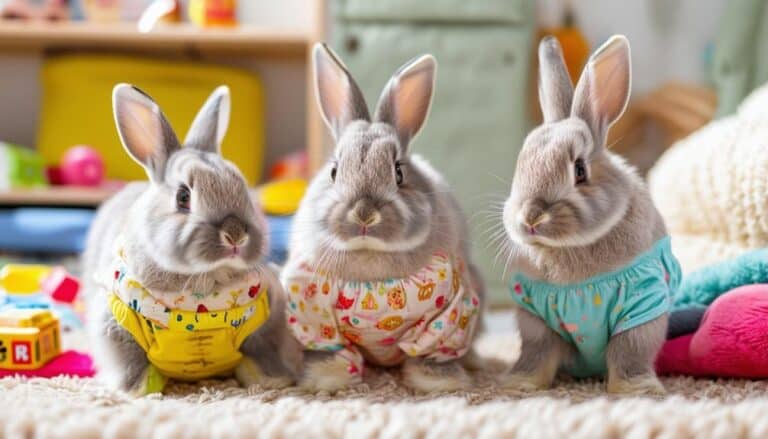Understanding Pet Rabbit Sounds: A Guide
When you hear your pet rabbit make various sounds, it’s not just random noise; each sound carries a specific message about their emotions and needs.
Understanding these vocalizations can greatly enhance your ability to care for and bond with your furry friend. For instance, do you know that teeth grinding might indicate pain or stress, while honking could mean your rabbit is feeling annoyed or wants more freedom?
By learning the nuances of these sounds, you’ll be better equipped to respond appropriately and safeguard your rabbit’s well-being. Curious about what other sounds might mean?
Teeth Grinding
Teeth grinding in rabbits, especially when loud and continuous, is a clear sign that your pet might be experiencing pain or stress. Unlike the gentle tooth purring that signifies contentment, loud teeth grinding is your rabbit’s way of communicating discomfort. If you hear these sounds, it’s essential to act promptly.
Pain in rabbits can stem from various issues like dental problems, gastrointestinal discomfort, or injuries. Don’t ignore these sounds; your pet’s well-being could be at stake. Immediate consultation with a veterinarian is important to diagnose and address the underlying cause of the pain.
Meanwhile, providing appropriate chew toys can help manage teeth grinding by keeping your rabbit’s teeth in check and preventing overgrowth. Regular dental check-ups are also crucial. They ensure your rabbit’s teeth remain healthy and catch potential issues before they escalate.
Understanding your rabbit’s sounds empowers you to take swift and appropriate actions, enhancing your pet’s quality of life. Paying attention to teeth grinding and recognizing it as a sign of pain or stress will help you maintain a happy, healthy rabbit, allowing you both to enjoy the freedom of a worry-free companionship.
Grunting
Grunting in rabbits often signals affection or contentment, but it can also reflect territorial behavior, especially when paired with circling. To understand these grunting noises, you need to pay attention to your rabbit’s body language and the context in which the grunts occur.
Grunting can be a sign of affection, especially if your rabbit grunts while being petted or during playtime. This is their way of communicating happiness and comfort with you. However, if the grunts are more intense and frequent, especially when another rabbit or person is nearby, it may indicate that your rabbit is feeling territorial.
To better interpret your rabbit’s grunts, consider these key points:
- Context Matters: Note when and where the grunting occurs. Is it during feeding, petting, or when another rabbit is near?
- Accompanying Actions: Look for actions like circling or nudging that accompany the grunts.
- Frequency and Intensity: Pay attention to how often and how loud the grunts are.
- Interaction History: Understanding your rabbit’s unique patterns can help you decipher their grunts more accurately.
Honking
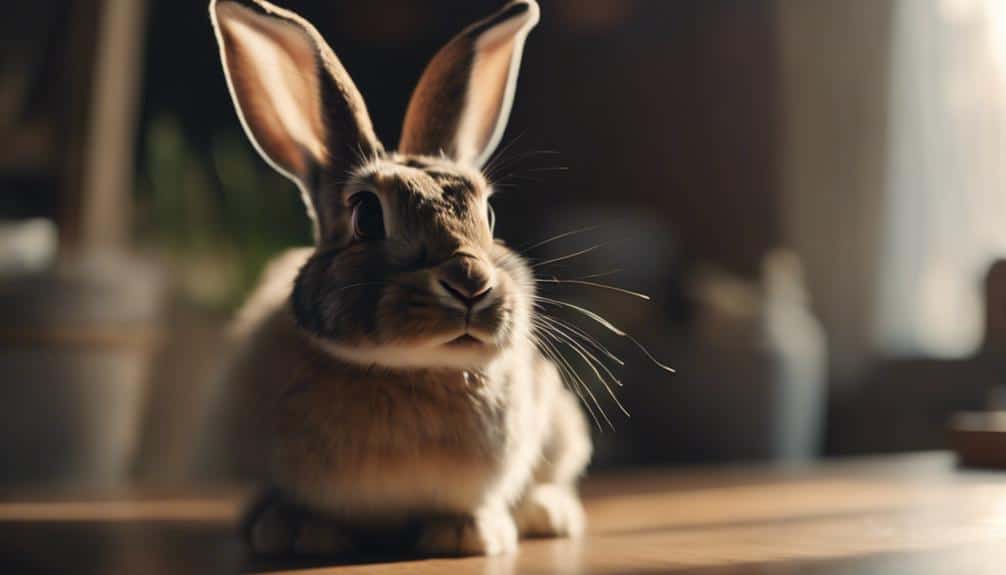
When your rabbit honks, it’s usually expressing annoyance or a strong desire for freedom to hop around. This sound often occurs when the rabbit feels restricted or its activities are interrupted, and it may be accompanied by pawing or nudging.
Learning to recognize and address honking can help you better understand and meet your rabbit’s needs, ensuring a more harmonious relationship.
Meaning of Honking
Honking in rabbits is an important vocalization that signals their annoyance or frustration, often arising when they feel restricted or desire more freedom to move. Rabbits use this sound to communicate their displeasure and agitation. If you hear your rabbit making honking noises, it’s vital to understand what they’re trying to tell you.
Here are four key reasons why your rabbit might be honking:
- Feeling Restricted: Rabbits enjoy hopping and exploring. Honking often indicates they want to move around more freely and feel confined.
- Seeking Attention: Sometimes, rabbits honk to get your attention. They may want to play or need some interaction.
- Protesting a Situation: If your rabbit is honking, it might be because they’re unhappy with their current environment or activities.
- Expressing Discontent: Honking can be a way for rabbits to express general irritation or impatience, different from other noises like purring or teeth grinding.
Understanding these vocalizations and the context in which they occur helps you respond appropriately to your rabbit’s needs. Recognizing the body language accompanying honking will further assist in interpreting their feelings and ensuring they enjoy the freedom they desire.
When Rabbits Honk
If your rabbit starts honking, it’s important to observe their surroundings and identify any potential sources of frustration or restriction. Honking in rabbits is a distinctive sound often signaling annoyance or displeasure. This vocalization occurs frequently when a rabbit is interrupted during its hopping or exercising freely.
Rabbits, much like humans, value their freedom and space. When they’re honking, it could be their way of communicating a desire to continue their activities without disturbances. Imagine your rabbit happily hopping around, and suddenly, a barrier or an unexpected intrusion disrupts their flow. This sudden change can lead to honking, expressing their irritation at the interruption.
Understanding the context behind your rabbit’s honking can be important. By observing when and why your rabbit honks, you can make adjustments to provide a more suitable environment.
Whether it’s removing obstacles or ensuring they’ve enough space and time to exercise, addressing these factors can greatly reduce honking behavior. Remember, a rabbit’s honk is more than just a sound; it’s a call for freedom and comfort in their environment.
Calming Honking Rabbits
To guarantee a spacious and quiet area for your rabbit to hop around freely, start by identifying and addressing the specific triggers causing their annoyance. Honking is often a sign that your rabbit is frustrated or wants more space.
Here’s how you can help:
- Assess the Environment: Guarantee your rabbit has a spacious and quiet area to hop around freely. Confined or noisy spaces can lead to increased honking.
- Provide Stimulation: Rabbits need mental and physical stimulation. Offer toys and allow for regular exercise to reduce their stress levels.
- Monitor for Pain: Sometimes honking can be accompanied by other signs of pain, like teeth grinding. If you notice any unusual behavior, consult a vet.
- Respect Their Space: If your rabbit is honking due to being interrupted during play, give them time to finish their activities without interference.
Clucking
Have you ever noticed your pet rabbit making a soft, hiccup-like sound while they doze peacefully? This delightful noise, known as clucking, is a sign that your rabbit is content and happy. When rabbits make this sound, it shows they’ve reached a state of deep relaxation and feel entirely secure in their environment.
Understanding rabbit noises, such as clucking, is crucial for gauging your pet’s overall well-being. This sound is typically heard during quiet, serene moments when your rabbit feels safe and undisturbed. It’s a soft, soothing noise that indicates they’re comfortable and at ease. If you hear your rabbit clucking, you can be reassured that they’re experiencing a moment of pure contentment.
Rabbits make this clucking sound almost subconsciously, often while they’re lying down and their teeth are slightly chattering in a rhythmic pattern. This gentle noise is a positive indicator and can help you understand your rabbit’s comfort level.
Purring
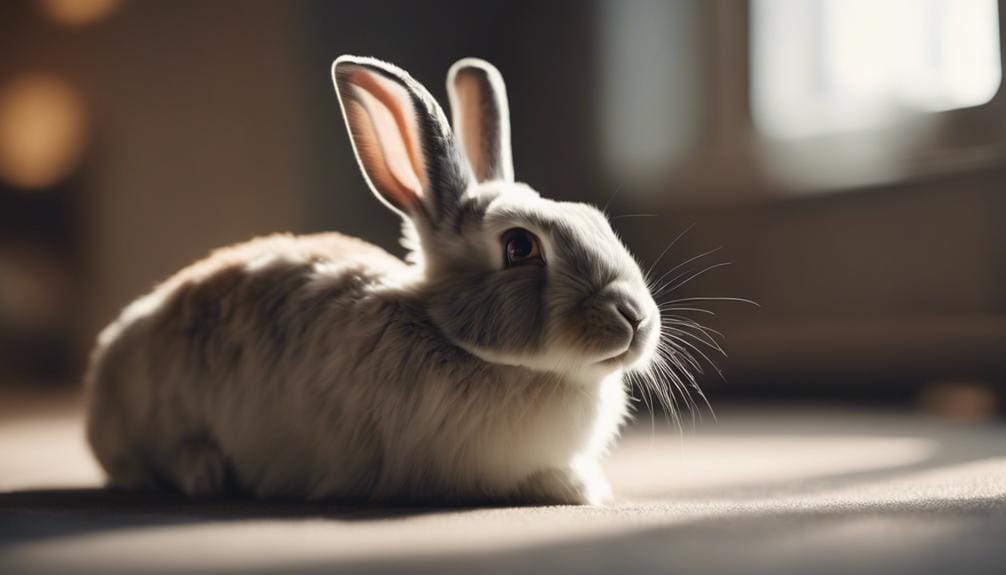
When your rabbit makes a soft, low sound by lightly rubbing their teeth together, it’s called purring. This gentle vibration is a clear indication of relaxation and contentment, often heard during petting sessions.
Understanding this soothing noise can help you better interpret your rabbit’s emotions and overall well-being.
Gentle Vibrations Explained
Purring in rabbits, a subtle sound produced by the gentle rubbing of their teeth, signifies a state of contentment and relaxation. Unlike teeth grinding, which can indicate discomfort or pain, purring is a positive form of communication that reflects your rabbit’s emotions. Understanding this gentle vibration can deepen your connection with your pet and provide insight into their well-being.
Here’s what you should know about rabbit purring:
- Contentment: When your rabbit purrs, it usually means they’re happy and comfortable. You might hear this sound when they’re being petted or snuggled.
- Feeling Safe: Purring often occurs when rabbits feel safe in their environment. This gentle sound is a sign they trust you and their surroundings.
- Enjoyment: If your rabbit purrs while exploring or relaxing, it’s a clear indicator they’re enjoying the moment and their current activity.
- Positive Interaction: Recognizing purring helps you better communicate with your rabbit, reinforcing positive emotions and strengthening your bond.
Purring and Relaxation
Recognizing the subtle, rhythmic sound of a rabbit’s purring can offer valuable insights into their state of relaxation and comfort. Rabbit purring is a soft, rhythmic grinding made by lightly rubbing their teeth together. This gentle sound signifies your rabbit’s contentment, indicating they feel safe and relaxed in their environment.
Often, you’ll notice this purring during petting sessions, where your rabbit is likely to be at their most tranquil. When you hear rabbit purring, it’s a clear sign of their positive emotional state. They might accompany the purring with gentle nudges or show relaxed body language, further reinforcing their comfort and happiness.
By understanding these signs, you can better gauge your rabbit’s emotional state and create a more serene environment for them. The ability to recognize and respond to rabbit purring enhances your bond with your pet, fostering a deeper connection.
It’s a rewarding experience to know your rabbit feels at ease and content in your presence. This knowledge empowers you to provide the freedom and comfort they need, ensuring their emotional and physical well-being in a stress-free environment.
Communication Through Purring
As you observe your rabbit closely, you’ll notice that their gentle purring serves as a nuanced form of communication, revealing their sense of contentment and security. Purring is a soft, rhythmic sound created when rabbits lightly rub their teeth together. It’s a clear indicator that your rabbit feels relaxed and happy, often heard during petting sessions or quiet moments when they feel safe.
Understanding your rabbit’s purring can help you better gauge their emotional state and enhance your bond with them. Here are some key points to take into account:
- Distinct Sound: Purring differs from grinding, which typically signals pain or stress. Recognizing this distinction ensures you respond appropriately to your rabbit’s needs.
- Positive Emotional State: When your rabbit purrs, they’re communicating a positive emotional state, indicating they trust you and feel secure in their environment.
- Bond Strengthening: Acknowledging and responding to your rabbit’s purring fosters a deeper connection, making them feel more comfortable and loved.
- Effective Communication: By understanding what purring signifies, you can better communicate with your rabbit, ensuring their happiness and well-being.
Paying attention to these subtle sounds allows you to create a more harmonious and responsive relationship with your pet rabbit.
Whining
Whining in rabbits is a vital form of communication that can reveal a lot about their emotions and needs. When your rabbit makes a whining noise, it’s trying to communicate something specific—perhaps curiosity, annoyance, or a desire for attention. Understanding the context of the whining is essential to interpreting your rabbit’s mood accurately.
Consider the following table to help you decode your rabbit’s whining:
| Whining Context | Possible Meaning |
|---|---|
| During Petting | Seeking more attention |
| Near Feeding Time | Hunger or excitement |
| When Caged or Restricted | Annoyance or frustration |
| Persistent and Unusual | Possible discomfort |
By recognizing these patterns, you can respond more effectively to your rabbit’s needs. For instance, if your rabbit whines during petting, it might be enjoying the interaction and wanting more. Conversely, persistent or unusual whining could signal discomfort or health issues that need addressing.
Responding appropriately to your rabbit’s whining can strengthen your bond and promote its well-being. Always keep an eye on the context and any accompanying behaviors to understand what your furry friend is trying to tell you. Remember, effective communication with your rabbit fosters a happier, healthier relationship for both of you.
Wheezing
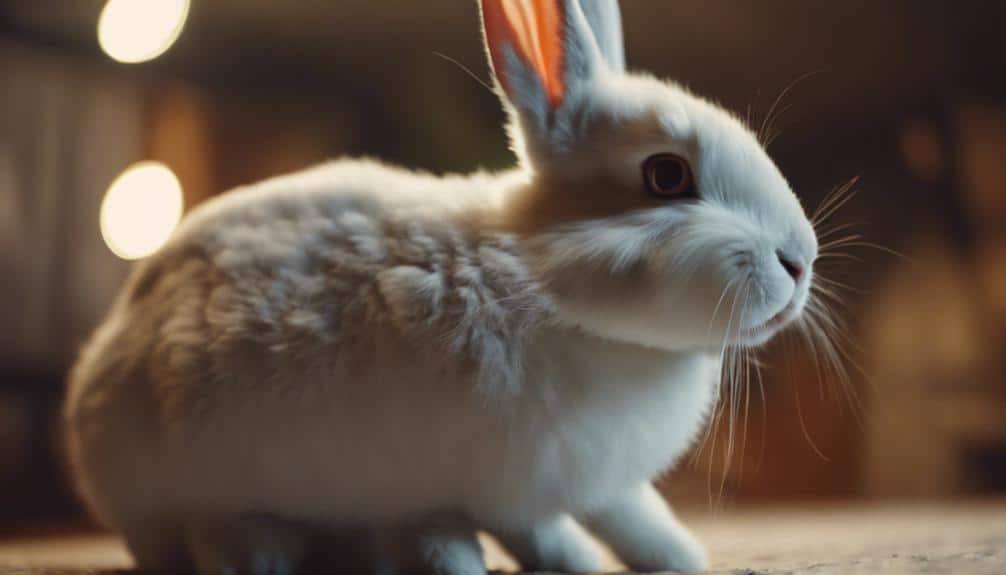
How can you tell if your rabbit’s wheezing is a sign of something serious?
Wheezing in rabbits might indicate respiratory issues or breathing difficulties, which shouldn’t be overlooked. While a big, wheezy sigh during rest can signify contentment, continuous wheezing needs closer attention. It’s important to differentiate between benign sounds and those that suggest underlying problems.
Monitor your rabbit’s wheezing patterns and look out for the following signs:
- Critical: If the wheezing is constant and doesn’t subside, it could be a symptom of respiratory issues.
- Accompanied by other symptoms: Look for labored breathing, nasal discharge, or coughing. These signs often accompany more severe conditions.
- Behavioral changes: Your rabbit might clench its teeth together, indicating extreme pain or distress.
- Environmental factors: Make sure there are no allergens or irritants in their environment that could be causing the wheezing.
If you observe any of these signs, it’s important to consult a veterinarian. They can evaluate your rabbit and determine if the wheezing is due to respiratory issues or another health concern. Prompt attention ensures your rabbit’s well-being and helps prevent serious complications. Remember, a proactive approach can save your pet from extreme pain and discomfort.
Screaming
Rabbit screaming is a rare but unmistakable sound that signals extreme fear or severe pain and requires immediate attention. When you hear a rabbit scream, it’s a sign that something is terribly wrong. This distressing noise can indicate that your pet is experiencing a life-threatening situation. Hence, it’s vital to act quickly and seek veterinary attention without delay.
Understanding the context of a rabbit scream is essential. It can occur due to a sudden traumatic event, such as an injury or a predator attack. Alternatively, it might be the result of severe pain from a health condition or injury. In any case, you mustn’t ignore or dismiss this alarming sound. Your prompt response can make a critical difference in your rabbit’s well-being and safety.
Blowing Noises
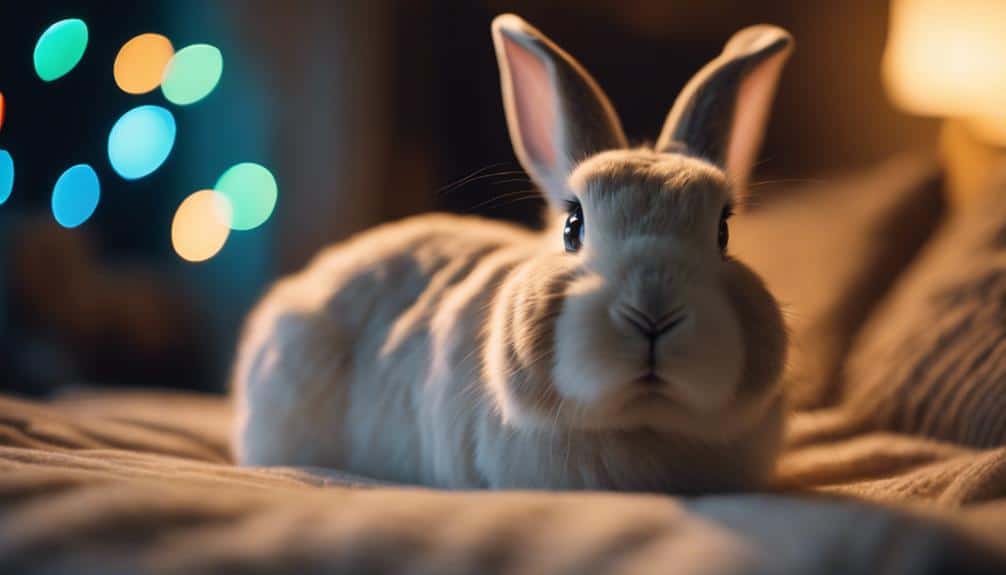
When your rabbit makes blowing noises, it’s often a sign of annoyance or nervousness that you should pay attention to. These sounds can be a precursor to more aggressive behaviors, so it’s essential to address the underlying cause promptly.
Here are some steps to help you manage and reduce these blowing noises:
- Identify Triggers: Pay close attention to what might be causing your rabbit’s annoyance or nervousness. Common triggers include sudden movements, loud noises, or changes in their environment.
- Neutering: If your rabbit isn’t already neutered, consider this option. Neutering can help reduce aggressive tendencies, which may decrease the frequency of blowing noises.
- Enrichment Activities: Boredom can lead to blowing noises. Make sure your rabbit has plenty of mental and physical stimulation. Provide toys, puzzle feeders, and opportunities for safe exploration.
- Safe Environment: Create a secure environment where your rabbit feels safe. This includes a quiet, comfortable space free from potential stressors.
Conclusion
By paying close attention to your rabbit’s vocalizations, you can better understand their emotions and needs. Recognizing sounds like teeth grinding, grunting, and honking helps you respond appropriately, guaranteeing their well-being.
Clucking and purring indicate contentment, while whining and wheezing may necessitate immediate attention. By creating a responsive and nurturing environment, you’ll strengthen the bond with your rabbit and make sure they feel safe, loved, and understood.
Your attentiveness makes all the difference in their happiness.

